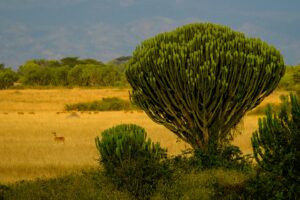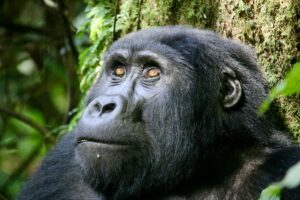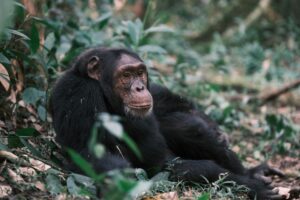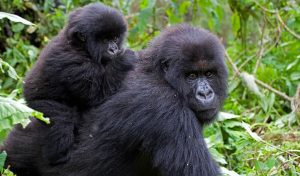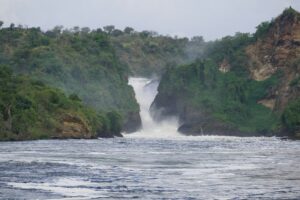Overview
The East African country of Uganda is a destination boasting brilliant game viewing, diverse landscapes, and a rich culture. There are 10 national parks, each offering unique landscapes and wildlife experiences. These parks range from savannah grasslands to dense forests and mountainous terrains, providing habitats for a wide variety of flora and fauna.
The national parks of Uganda contribute to conservation efforts and tourism in the country and are significant for their biodiversity, including endangered species like mountain gorillas. Eco-tourism is key to supporting Uganda’s economy, with the national parks playing a large role in protecting Uganda’s heritage.
Uganda’s national parks vary in size, location, and diversity when it comes to landscape, wildlife complement, and community involvement. One thing they all have in common, is that no matter which park you choose to visit, each destination will provide you with an incredible and most memorable wildlife and wilderness experience.
Queen Elizabeth National Park
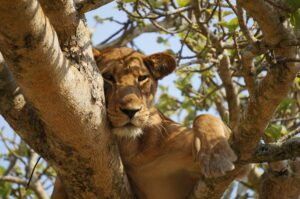
Location and Landscape
Queen Elizabeth National Park is located in Uganda’s southwest, standing as the country’s second-largest park, covering around 760 sq miles. It spans several districts and lies around 250 miles southwest of the capital, Kampala, a five to six-hour drive. The Park is located near the districts of Kasese, rich in bodies of water, and Fort Portal, a convenient stop for tourists visiting the region, with cultural activities on offer. Visitors can also look to fly into Mweya or Kasese.
The diverse landscape of Queen Elizabeth National Park includes savannah grasslands, forests, wetlands and the Kazinga Channel, which connects Lake George and Lake Edward. This diversity not only supports a wide variety of wildlife, mammals, and birds, but it also contributes to its status as a top destination for eco-tourism in Uganda.
Wildlife and Biodiversity
With a diverse ecosystem, Queen Elizabeth National Park is a wildlife haven, and home to over 95 mammal species and 600 bird species. The savannah grasslands are the ideal location for spotting large herbivores like elephants and the Uganda Kobs, while dense forests provide a habitat for primates and other wildlife.
The Park’s wetlands are crucial for birdlife and support a variety of aquatic species including the sacred ibis and the saddlebill stork. The Kazinga Channel is an incredible body of water with the banks alive with an array of animals coming to drink from the gently flowing waters, with a high concentration of hippos and crocodiles.
Activities and Visitor Experience
Queen Elizabeth National Park is renowned for its unique attractions such as the tree-climbing lions which can be spotted in the Ishasha sector of the Park. Boat cruises along the Kazinga Channel offer a scenic ride past river banks packed with animals from buffalos and elephants, to pelicans and storks. Visitors have a chance to see pods of hippos dotted along the Channel during their boat ride, before returning to safe shore, perhaps for a picnic.
Local communities live near the water’s edge, and visitors may have the opportunity to see them washing clothes in the shallow water along the shore, often singing along to the chore. These fascinating features of the Queen Elizabeth National Park make it a popular choice for safari-goers seeking to experience Uganda’s natural beauty and prove a vital area for conservation efforts in the country.
Visitors may look to embark on an itinerary that includes a combination of Queen Elizabeth National Park with a gorilla trekking adventure in Bwindi Impenetrable National Park.
Bwindi Impenetrable National Park
Location and Landscape
Bwindi Impenetrable National Park is located in southwestern Uganda, covering the districts of Kanungu, Rubanda, and Kisoro. It borders the Democratic Republic of Congo to the west and is 18 miles from the town of Kibale, located to the southeast. The capital, Kampala, lies 330 miles away. Located in the Kigezi Highlands, overlooking the western rift valley, the Park’s altitude ranges from 3800 to 8550 feet above sea level.
Bwindi is known as the home of mountain gorillas, and as such, is characterized by steep slopes and high altitude forests. The Park is divided into the following sectors: the Bhomo sector, located in the northwest; the Ruhija sector, located in the east; the Nkuringo sector, located in the southwest and the Rushaga sector, located in the southwestern part of Bwindi Impenetrable National Park.
Wildlife and Biodiversity
It features dense, impenetrable forest vegetation and a combination of lowland and montane forest ecosystems, with the Ivi River in the northwestern part and the Ruvumu River in the southwestern part of the Park. The Park’s unique landscape and location contribute to its rich biodiversity, making it a crucial habitat for mountain gorillas and numerous other species.
Bwindi’s varied terrain and high-altitude forests create a challenging but rewarding environment for wildlife viewing and conservation efforts. The Park’s biodiversity is exceptional, with over 120 mammal species, 346 bird species, and 202 butterfly species.
Activities and Visitor Experiences
The key reason for visitors to venture to Bwindi would be to embark on a mountain gorilla trek, and while this incredible experience can be enjoyed throughout the year, the peak seasons are from June to August and from December to February. The Park experiences a tropical climate, with two wet seasons during the year. Visitors can enjoy sightings of other wildlife during their adventure, keeping an eye open for birdlife in the trees around them. Cultural experiences are also offered to visitors, with local communities sharing insights into their heritage, traditions and daily life today.
Kibale National Park
Location and Landscape
Kibale National Park is situated in western Uganda, encompassing the districts of Kabarole and Kamwenge. It covers an area of approximately 300 sq miles and is located about 215 miles outside the capital, Kampala. The altitude ranges from 3600 feet to 5250 feet above sea level, and the landscape comprises dense, evergreen rainforest with varied terrain, including hills, valleys, and wetlands. The forest mostly covers the central and northern part of the Park, on the raised Fort Portal plateau, the incredible landscape offers tracks and trails for visitors to explore wildlife and wilderness.
Wildlife and Biodiversity
Kibale National Park is renowned for its exceptional biodiversity, particularly its primate population. It is home to 13 primate species, including the largest population of chimpanzees in Uganda. Other primates include the Uganda red colobus, Uganda mangabey, L’Hoest’s monkey, black and white colobus, and blue monkeys. With over 370 bird species, the Kibale National Park is a birdwatcher’s paradise, and wildlife enthusiasts can enjoy sightings of bushbuck, elephants, and other small mammals.
The biodiversity of the Kibale National Park includes a combination of lowland and montane forest ecosystems and is home to a variety of plants and microorganisms that usually live in forests, many native to Kibale National Park.
Activities and Visitor Experiences
Kibale National Park offers a wide range of activities for visitors, with the highlight being chimpanzee trekking. This ‘flagship’ activity allows visitors to observe chimpanzees in their natural habitat for one hour. Visitors have the chance to enjoy a more immersive experience where they will spend around four hours with the chimpanzees, observing their behavior. This is known as the Chimpanzee Habituation Experience. Visitors can enjoy guided nature walks and hikes through the forest, with a chance to observe diverse flora, fauna and landscapes. With over 370 bird species, Kibale is an excellent destination for birders. A visit to the local Bakiga and Batooro communities will give visitors insight into traditional lifestyles, dances, and crafts. Some visitors may wish to combine their chimpanzee tracking with a gorilla trek in Bwindi.
Mgahinga Gorilla National Park
Location and Landscape
Mgahinga Gorilla National Park is located in southwestern Uganda, bordering Rwanda and the Democratic Republic of Congo. The Park forms part of the Virunga Conservation Area and the Volcanoes National Park, both in Rwanda, and the Virunga National Park in the DRC. Mgahinga Gorilla National Park is Uganda’s smallest national park, with altitudes ranging between 7300 feet to 13540 feet above sea level. Temperatures vary depending on altitude, averaging around 68 F during the day and 48 F at night on lower slopes. Mgahinga Gorilla National Park features three extinct volcanoes, namely Muhavura, Gahinga, and Sabinyo.
Wildlife and Biodiversity
Despite being a small national park, Mgahinga boasts a rich biodiversity, with over 76 mammal species recorded, and around 115 bird species. These include 12 Albertine Rift endemics and other incredible species such as the Rwenzori Turaco. The Park is home to mountain gorillas, including the habituated Nyakagazi family, with a large population of golden monkeys which can only be located in this region of Uganda. Other notable species include the black and white colobus monkeys, leopards, elephants, and buffalo.
The Mgahinga National Park is characterized by a dramatic volcanic skyline and diverse habitats including montane woodland, montane forest, and bamboo forests. The Park boasts rich plant diversity due to varied altitudes and habitats.
Activities and Visitor Experiences
The main focus of a visit to the Mgahinga National Park is to embark on a mountain gorilla trek. Visitors will observe the Nyakagazi gorilla family in their natural habitat. Golden Monkey Tracking is a unique opportunity for visitors to see these rare primates. Guests can explore the Park’s diverse ecosystems and take in captivating, panoramic views, including lakes Mutanda and Bunyoni. Guiding trails include Gahinga Peak, Sabyinyo and Muabura Peak. Cultural experiences include a visit to the indigenous Batwa people, where visitors can learn about their heritage and forest culture.
Murchison Falls National Park
Location and Landscape
Murchison Falls National Park is located in Uganda’s northwest and spans the districts of Buliisa, Nwoya, Kiryandongo, and Masindi. The area covers around 1480 sq miles and is characterized by savannah grasslands, tropical forests, woodlands, and wetlands. The Park is bisected by the Victoria Nile, which plunges magnificently 140 feet over the Murchison Falls rift valley wall. The dramatic Murchison Falls is a highlight feature of the Park, where the Nile River squeezes through a 7-meter wide gorge.
Wildlife and Biodiversity
Murchison Falls National Park boasts rich biodiversity, with around 75 species of mammals and over 450 species of birds that call the Park, home. Wildlife visitors can see in the park include elephants, giraffes, lions, leopards, and hippos. There is a large population of Uganda kob, waterbuck, and buffalo, with Nile crocodiles often seen in large numbers along the river banks. The rare shoebill stork can be spotted in the delta area, with chimpanzees living in the Budongo Forest section of the Park.
Activities and Visitor Experience
Activities at Murchison Falls National Park include excursions on land and water, with 3-4 hour game drives in the northern part of the Park. Visitors can view wildlife in savannah grasslands, with opportunities to see incredible birdlife. This comprehensive safari destination will introduce you to exciting adventures such as chimpanzee trekking and habituation experiences, in the Budongo Forest section.
Boat cruises are popular at Murchison Falls, with two options: The Albert Delta cruise is a f 4-5 hour trip that travels towards Lake Albert, ideal for visitors who love birds; The launch trip is a 3-hour cruise that moves upstream from the base of Murchison Falls, with a chance to see elephants on shore, as well as hippos and crocodiles. Other activities include hiking to the top of Murchison Falls, a cultural village visit, zip lining and canopy walking, and even the opportunity to go fishing on the Nile River.
Other National Parks in Uganda
The remaining national parks in Uganda may be smaller in size and recognition, however, they boast outstanding features that make them worth a visit in addition to the main and most-known lodges. These other parks include:
Rwenzori Mountains National Park
Rwenzori Mountains National Park is a UNESCO World Heritage site known for its “Mountains of the Moon”. It offers world-class hiking and mountaineering opportunities, with diverse ecosystems, ranging from rainforests to alpine meadows.
Kidepo Valley National Park
The Kidepo Valley National Park is located in Uganda’s remote northeast and is known for its rugged savannah landscapes and unique wildlife. Several species, including ostriches and cheetahs are found solely in this Park.
Lake Mburo National Park
Lake Mburo National Park is Uganda’s smallest savanna national park and is notable for its wetland system, part of the Ramsar Wetland, and offers diverse birdlife. it’s the only park in Uganda where you can find impalas.
Semuliki National Park
Semuliki National Park is located in the Albertine Rift Valley and is known for its hot springs and diverse bird species.
Mount Elgon National Park
The Mount Elgon National Park is centered around the extinct Mount Elgon volcano and offers excellent hiking opportunities, with wonderful sightings of unique flora and fauna which is adapted to high altitudes.
Conclusion
Uganda’s national parks are diverse, each offering unique landscapes and wildlife experiences. They provide critical habitats for numerous species and are integral to Uganda’s ecological health and economy. From the dense forests of Bwindi Impenetrable National Park and the incredible mountain gorillas to the expansive savannahs of Murchison Falls National Park and its breathtaking waterfall. There are many activities guests can enjoy during their adventures in Uganda, such as gorilla trekking, game drives, birdwatching, and more. The destination is ideal for adventure-seekers and nature lovers, with incredible scenery at every turn. As Uganda continues to prioritize conservation efforts, these national parks not only protect invaluable ecosystems but also promote sustainable tourism that benefits local communities and preserves the country’s rich natural heritage. Our 20 Days Discover Uganda Wildlife Cultural Safaris can offer a well-rounded tour of all these major parks.

